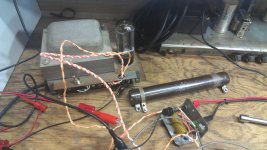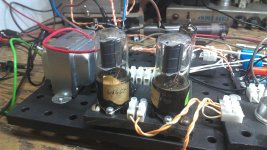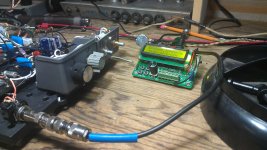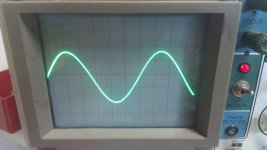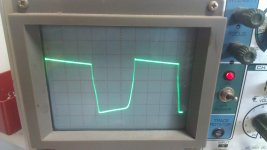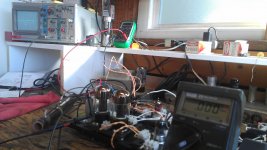Having too much fun! have some 6Y6s and 6K6s, want to see what lower power tubes do. Am looking at tube data sheets, plate voltages, cathode bias, plate dissipation, AND power supply loading. Realized I had been using my Champ-sized PT (70 mA) on this Deluxe breadboard. Am drawing 80 - 100+ mA..... OK, so how do I reduce the supply current demand? Plugged in two 6K6s, tube data showed similar plate B+ and cathode resistance (400) to 6V6s, and the amp worked well, only 32 mA plate current at 345 V on plate (6V6s ran at 41). Still too much draw on the supply. This is where I know just enough to be dangerous..... Thought I could lower the plate voltage with dropping resistors on the plate leads. Installed two 1800 1W guys, and.....one 6K6 showed 317V on its plate, the other 372!! And then the amp started fading (have a 4 ohm spkr cab and 4 ohm dummy resistor switchable, and a sig gen at guitar level providing signal). Current draw from the supply dropped off. Shut it down. Removed the plate resistors, everything still works. Hmm... How can I lower plate supply (other than a whole different xfmr/tube or SS setup? Preamp tubes use that 100K to set plate voltage... The 6Y6 needs only 200 V of plate voltage... Any thoughts? Thanks! Jeff
I haven't looked at the datasheets in a while so this is off the top of my head. But I believe that 6k6's will want a higher plate load impedance, so if you have an 8 ohm load/speaker use the 4 ohm tap of transformer. Also to lower the current draw from output tubes if your amp is cathode bias you will need to increase the size of the cathode resistor on the power tubes, go from 250 to something like 300 ohms should get you down to safe current draw with that transformer. Also the plate of the 6k6's is fine with those voltages but i am not sure about the screen.
Last edited:
Thanks! I'm doing just the opposite with my OT - has only an 8 ohm tap, and I have a 4 ohm load on it. Will go to 8 ohm.... Will play with the cathode resistor, but I want to keep the bias centered. I DO have a large adjustable power resistor, may try it on the B+ from the supply to lower the plate voltage. My goal is to see how low a draw I can put on my pwr supply but still keep the power section happy. I can adjust voltage dropping resistors to the preamp if I need to to keep it happy to. Want SOME clipping/breakup, may have to settle for getting it from the preamp - and keep the pwr section clean, to keep overall current draw down. If output wattage suffers, that's ok. Want to get good sounding breakup without blasting the neighbors anyway (but be louder than a Champ!).
To get a 100 volt drop to power tube plates via a large resistor you would need a value of 1k ohms rated at least 30 watts! That's a big variable resistor. Good luck.
Just remember to get the power tubes near plate dissipation you want for a 5E3 when you lower plate voltage current WILL increase putting you over your power transformers 70mA limit.
Just remember to get the power tubes near plate dissipation you want for a 5E3 when you lower plate voltage current WILL increase putting you over your power transformers 70mA limit.
Last edited:
Yes, lowering your B+ isn't really the solution. Biasing the 6V6's colder to decrease their current draw is the best way. I wouldn't be terribly concerned about being over a little bit on the PT B+ winding. Those old transformers are underrated and pretty tough. However, look at your 6.3V heater winding. The extra tubes in your amp will be drawing a lot more heater current. 6V6 heaters are 0.5A each and 12a?7's are 0.3A's each.
I took a quick look at the Hammond replacement for the Champ and they spec 2A on the 6.3V winding, so you should be okay there since you're at 1.6A.
To give you an idea of how robust these old transformers can be (don't take it as gospel, but this is my experience), my Fender Super Reverb has been heavily modified. It has 2x 6550 instead of the stock 2x 6L6. It does have a second PT for the plates and screens, but the OT is stock! The amp outputs over 100 watts before it starts to clip. The OT does get warm, but I ran it like that for many years and it still works great. If the PT's are of similar robustness, then I wouldn't be worried if I were you. If you cool down the bias on your 6V6's then it probably won't sound as good. 😉
Speaking of sounding good, you're so excited about this amp, can we hear some sound clips?
To give you an idea of how robust these old transformers can be (don't take it as gospel, but this is my experience), my Fender Super Reverb has been heavily modified. It has 2x 6550 instead of the stock 2x 6L6. It does have a second PT for the plates and screens, but the OT is stock! The amp outputs over 100 watts before it starts to clip. The OT does get warm, but I ran it like that for many years and it still works great. If the PT's are of similar robustness, then I wouldn't be worried if I were you. If you cool down the bias on your 6V6's then it probably won't sound as good. 😉
Speaking of sounding good, you're so excited about this amp, can we hear some sound clips?
Thanks for all the interest and ideas! And yes I'll post some sound clips, when I get by breadboard back to it's original configuration.... The massive PT in the pic is from an old Hammond organ - it had 2 6V6s PP and about 40 other tubes, so it should handle my filament needs! Also shown is a 500 ohm 175W adjustable power resistor, for reducing plate voltage, and a 4 ohm 50W dummy resistor and speaker switchboard...... Next pic shows 2 6K6s, next to a Weber W041318 OT (6600 pri, 8 sec, 25W). Another shows my preamp and pwr section gain pot module, and a tone stack module (bass & treble pots) - currently not in the circuit (lifted the ground). Finally, 3 scope shots (off the dummy load), with medium gain settings, preamp pushed, and both preamp and pwr section pushed. I want to run a bunch of tests with different power tubes, with different plate B+, cathode bias, etc and record PT current, plate current, breakup characteristics, total wattage, etc. Then when I want to build an amp for a specific use, I have a better idea what parts to put together. I have 6Y6s, 6L6s and a pair of little 6AQ5As as well. This could take a while.... And then there's changing the PI....
Attachments
News Flash.... first test: lowered B+ to 6K6 plates from 360 to 312 VDC (added 1000 ohms to OT center tap), and lowered screen (glad I remembered to!) from 285 to 216 (added 5600 ohms). Fired it up, plate current only 25 mA (ea tube) and power supply draw was only 63 mA (no signal) to 71 mA (max signal)!! Breakup came earlier on scope, guitar had more distortion than I'd like, but bias adjust should fix that. BUT.... I have a 15W Deluxe that I can power with a Champ PT (that was my goal).
I don't think you need the extra 5600 ohms on the screens to drop them down so much. The datasheet for a 6k6gt is 315 plate and 285 screen.
Instead of using the big resistor to drop B+ you could just run the rectifier as a half wave and get roughly the same results without wasting power to heat.
Keep it up I like where this is going, I have a bunch of 6k6gt's I might try in my 5E3 clone.
BTW what is your power output with the 6k6's?
Also I only get about 12 watts out of my 5E3 clone with the same voltages (roughly 360 on the plates) before clipping with 6v6's. This was with a 250mV 1khz signal. Maybe you have better OPT iron than me?
Instead of using the big resistor to drop B+ you could just run the rectifier as a half wave and get roughly the same results without wasting power to heat.
Keep it up I like where this is going, I have a bunch of 6k6gt's I might try in my 5E3 clone.
BTW what is your power output with the 6k6's?
Also I only get about 12 watts out of my 5E3 clone with the same voltages (roughly 360 on the plates) before clipping with 6v6's. This was with a 250mV 1khz signal. Maybe you have better OPT iron than me?
Last edited:
You are correct - I just wanted to be sure screen voltage stayed below plate. I lowered the plate B+ more (turns out my 500 ohm power resistor is actually 2500 - measured it - the "2" must have faded...) down to 236V, leaving the 5600 added screen dropper. Screen stayed about 213V (OK). Plate current went down to 23 mA (per tube), which calcs out to 5.14W/per tube: (Vplate-Vcathode) x plate current. I had 12.5Wx2=25 watts with 6V6s, with 356V plate, 17V cathode, and 37 mA plate. This was with no input signal (didn't seem to change with signal - these are DC watts not audio power?). One thing I did notice when I reduced the plate B+, clipping came earlier, and closely comparing the scope at max gain (for lowering plate voltage) showed a reduction of the peak-to-peak height. Is this "Headroom" diminishing? I need to learn more about that. Stuff like voltage swings, etc I see online. I gotta lot to learn.....
Last edited:
"these are DC watts not audio power?"
Yes that is plate dissipation not audio power out. To get audio power out measure AC voltage on your dummy load (with a signal) and watch your scope, turn the volume up and right before it starts to clip take your AC reading and square it, then divide by the dummy load.
example (10vac^2) / 8 = 12.5
Yes that is plate dissipation not audio power out. To get audio power out measure AC voltage on your dummy load (with a signal) and watch your scope, turn the volume up and right before it starts to clip take your AC reading and square it, then divide by the dummy load.
example (10vac^2) / 8 = 12.5
FMB: By the way, the first thing I did with my 6K6s is just swap them into this 6V6 breadboard Deluxe amp. Was running 350 Vplate, 18 Vcathode, they stayed about the same (with 6K6s), but plate current went from 37mA to 32, giving about 10.5W/tube. I'm measuring my plate current through 1 ohm 1% resistors. The reason I'm playing with lower plate voltages (besides just seeing what happens) is that I have a pair of 6Y6s, which run at 200 Vplate and 135 Vscreen, but plate diss is 12.5W (each!). Thats my next test.
The driver tubes are to bring up the voltage to satisfy the power section. The datasheets say for class A one tube a 6V6 max AF signal to grid 1 is 13v for 5.5watts@315v, for 6K6 max AF signal to grid is 21v for 4.5 watts@315v. So for roughly the same power output you need a larger voltage swing for a 6K6 than a 6V6.
I will try to find a datasheet for a 6Y6.
I will try to find a datasheet for a 6Y6.
Last edited:
OK....a larger voltage swing... meaning...more preamp gain? BTW, my 5E3 has an extra gain stage, I only have one input, so used both halves of the 12AX7 for gain (ala the AA764). And, the best I could get with 6V6s on my breadboard was 5.8 VAC into 4 ohms, which is only 8.4 watts. It sure sounds louder than that!
To gain 3db you need to double wattage so 8.4 to say 12 isn't going to be a night and day noticeable difference.
Last edited:
Now that I re-read your post, since you have one channel and used both triodes of the 12ax7 in one gain stage did you parallel them? If so you would have to halve the plate load resistor to get the same gain results. So instead of 100K use 47K.
No, I put them in series like the Champ AA764: Davidson Amplifier Repair, Nashville, TN : Schematics: Fender: Champ Amp AA764 Schematic . I am not using the tone stack, so I have plenty (too much?) gain!
To reduce distortion, I plan to do add a stopper to the PI pin 7, adjust the cathode bias, and do more testing and graph plate voltage vs voltage swing, for future use of this tube.
To reduce distortion, I plan to do add a stopper to the PI pin 7, adjust the cathode bias, and do more testing and graph plate voltage vs voltage swing, for future use of this tube.
6K6s AND 6Y6s IN MY DELUXE BREADBOARD
Was able to lower my plate B+ from 350 to 208 volts, with my monster 2500 ohm power resistor (see pic), and ran 5 tests on two 6K6s, at different levels, noting plate current, supply current, and a 400Hz sine wave on the plate and spkr. Even ran the plate 50 volts lower than the screen! Just to see what it did.... Then having a low Vp available I plugged in my two 6Y6s (see pic-they're big bottles!). Tube data specs 200/135 max plate/screen. Closest I could get was 233/176 (plate/screen), but got 42 mA plate current. Getting a bit tired of making square waves though, will start adding grid stop resistance to the PI (have none now!), to clean up the signal. Play with cathode bias too. My breadboard has gotten so "Frankenstein'ed" I hope I can put it back to normal (I have that data too...somewhere!).
Was able to lower my plate B+ from 350 to 208 volts, with my monster 2500 ohm power resistor (see pic), and ran 5 tests on two 6K6s, at different levels, noting plate current, supply current, and a 400Hz sine wave on the plate and spkr. Even ran the plate 50 volts lower than the screen! Just to see what it did.... Then having a low Vp available I plugged in my two 6Y6s (see pic-they're big bottles!). Tube data specs 200/135 max plate/screen. Closest I could get was 233/176 (plate/screen), but got 42 mA plate current. Getting a bit tired of making square waves though, will start adding grid stop resistance to the PI (have none now!), to clean up the signal. Play with cathode bias too. My breadboard has gotten so "Frankenstein'ed" I hope I can put it back to normal (I have that data too...somewhere!).
Attachments
I tried a large 1M grid stopper at the split load PI on my 5E3 and didn't like the sound. I wouldn't try to clean up the signal too much I think that is partly the reason why these amps sound so good.
I just put a 500K pot on pin 7 of my PI (grid), but I still have two 6Y6s in it, and have voltages all jacked right now, but will be going back to 6V6s soon to try the stopper pot on them.
- Status
- Not open for further replies.
- Home
- Live Sound
- Instruments and Amps
- PLAYING WITH MY DELUXE 5E3 BREADBOARD
